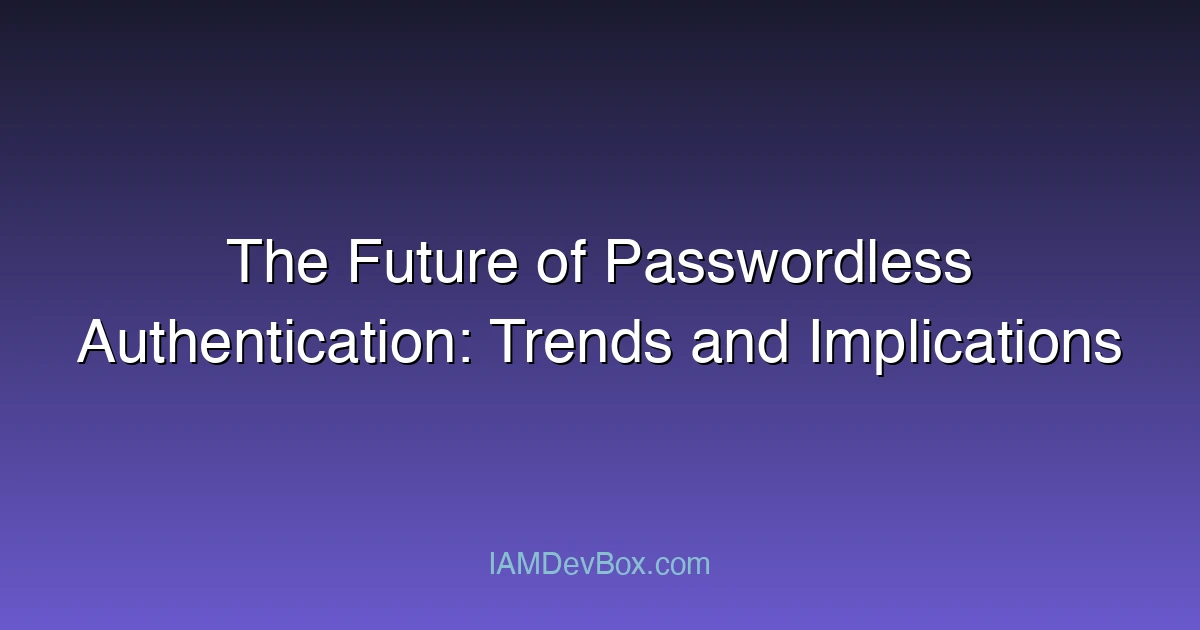Visual Overview:
graph TB
subgraph "Zero Trust Architecture"
User[User/Device] --> Verify{Identity Verification}
Verify --> MFA[Multi-Factor Auth]
MFA --> Context{Context Analysis}
Context --> Policy{Policy Engine}
Policy --> |Allow| Resource[Protected Resource]
Policy --> |Deny| Block[Access Denied]
Context --> Device[Device Trust]
Context --> Location[Location Check]
Context --> Behavior[Behavior Analysis]
end
style Verify fill:#667eea,color:#fff
style Policy fill:#764ba2,color:#fff
style Resource fill:#4caf50,color:#fff
style Block fill:#f44336,color:#fff
In an era where digital identities are increasingly valuable, traditional password-based authentication is proving to be a liability. Password fatigue, phishing attacks, and credential stuffing are just a few of the challenges that have pushed organizations to seek more secure and user-friendly alternatives. Enter passwordless authentication—a paradigm shift in how we verify identities. This blog post explores the current state, benefits, challenges, and future trends of passwordless authentication, backed by real-world examples and technical insights.
The Rise of Passwordless Authentication
Passwordless authentication eliminates the need for users to remember complex passwords, instead relying on alternative methods such as biometrics, one-time codes, or cryptographic keys. This shift is driven by several factors:
-
Improved Security: Passwords are inherently insecure. They can be guessed, stolen, or reused across multiple accounts. Passwordless methods, especially those leveraging FIDO2 and WebAuthn standards, use public-key cryptography to ensure secure and tamper-proof authentication.
-
Enhanced User Experience: Users no longer need to juggle multiple passwords. Instead, they can authenticate using biometrics (e.g., fingerprint or face recognition) or a simple tap on their smartphone.
-
Regulatory Pressure: Increasing data protection regulations, such as GDPR and CCPA, have made organizations more accountable for securing user data. Passwordless solutions align with these requirements by reducing the attack surface.
How Passwordless Authentication Works
To understand the future of passwordless authentication, it’s essential to grasp how it works. Here’s a simplified overview of a typical passwordless flow using FIDO2:
In this flow:
- The user initiates a login request.
- The device (e.g., smartphone or laptop) generates a cryptographic proof using a private key stored securely.
- This proof is sent to the identity provider for validation.
- If successful, the user gains access to the protected resource.
Real-World Applications and Use Cases
Passwordless authentication is already being adopted across various industries. Here are some notable examples:
-
Banking and Finance: Major banks are integrating biometric authentication for mobile banking apps, reducing the risk of account takeovers.
-
Enterprise Access: Companies like Microsoft and Google are leveraging passwordless methods for employee access to sensitive systems.
-
E-commerce: Online platforms are using one-time codes sent via SMS or email for passwordless login, enhancing both security and convenience.
Challenges and Considerations
While passwordless authentication offers significant advantages, it’s not without challenges:
-
Device Dependency: Users must have access to their enrolled devices to authenticate, which could be problematic in certain scenarios.
-
Implementation Complexity: Organizations need to invest in infrastructure and training to support passwordless solutions.
-
User Education: Transitioning from passwords to passwordless methods requires educating users about the new authentication流程.
The Future of Passwordless Authentication
The future of passwordless authentication is bright, but its adoption will depend on several factors:
-
Standardization: Widespread adoption of standards like FIDO2 and WebAuthn will drive consistency and interoperability across platforms.
-
AI and Machine Learning: Advanced algorithms can enhance fraud detection and risk-based authentication, making passwordless systems even more secure.
-
Zero Trust Architecture: Passwordless authentication will play a critical role in zero trust models, where every access request is verified before granting access.
Conclusion
Passwordless authentication represents a significant step forward in the evolution of digital security. By eliminating the vulnerabilities associated with traditional passwords, organizations can create more secure and user-friendly authentication experiences. However, the journey to widespread adoption will require collaboration between industry leaders, developers, and end-users.
As we move toward a passwordless future, the question is not if but when organizations will embrace this paradigm shift. Will your organization be among the early adopters?
Extended Questions for Readers
- How do you see passwordless authentication impacting your industry in the next 5 years?
- What steps can organizations take to address the challenges of implementing passwordless solutions?
- How can governments and regulators encourage broader adoption of passwordless authentication?
Let me know your thoughts in the comments below!
